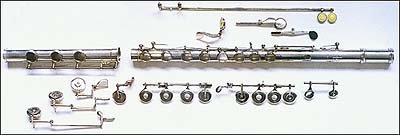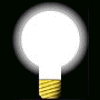
 |
Alternative Homework Assignment: Musical Instruments |
Carl and Beth have recently learned to play the flute and the violin. After many weeks of practicing, the time for their first recital has arrived. Unfortunately, traffic has made them quite late in getting to the recital hall and they are forced to skip their warm up excercises and go directly onto the stage. Listening carefully to a a concert A from an electronic tuner, they correctly tune their instruments. Satisfied with their intonation, they begin their recital. They are both well practiced, and the recital seems to be going very well, but as they reach the end of their first piece they notice that their instruments seem to be out of tune. The final note is suposed to be a pleasing harmony, but the intrument's tuning causes the audience to cringe. Beth and Carl have played their instruments correctly, but the recital has turned into a disaster. To see how this occured, and what the musicians need to do to prevent it in the future we will consider the instruments one at a time.

Part 1:
a) Consider Carl's flute as a pipe with two open ends that resonates at it's fundamental frequency. The pitch of the flute can be changed by opening holes in the side of the flute, effectively shortening the pipe. The hole on the side of a flute are not large enough to truly be treated as the open end of a pipe, but this is a good first approximation to the system. With this in mind, calculate the distance from the hole in the flute's mouth piece, to the opening that is left open when playing a concert A (440 Hz) using the simple open pipe model and a temperature of 20 degrees centigrade. Does the ability to play this note place an upper limit or a lower limit on the length of the flute?
b) As Carl plays, warm air passes through the flute raising it's temperature from the above mentioned 20 degrees centigrade, to a temperature near body temperature. If the flute warms up to 30 degrees centigrade, what is the new velocity of sound in the air inside the flute?
c) This change in temperature will also change the length of the flute. If the flute is made of silver, what is the change in it's length?
d) What is the new frequency the flute plays when Carl attempts to play a concert A?
e) Which effect (the change in length, or the change in the sound speed) is more important in changing the pitch of the flute?
f) To put this change of frequency into perspective, consider that the musical intervals are defined by frequency ratios. For example, the frequency ratio between two adjacent notes on a keyboard is f2/f1=2^(1/12). This is called a semitone or half-step, and is a fundamental ratio in western music. Find the ratio between the fute's old pitch and it's new pitch, and compare the change in pitch to a semitone. Is this a noticable change in pitch?
g) How much should Carl change the length of his flute to restore the pitch to 440 Hz?

Part 2:
a) Now consider Beth's intrument. In a violin, the frequency of the sound is determined almost entirely by the frequency of the string's vibration. The rest of the instrument is designed to amplify these vibrations. The A string has a length of about .4m and a linear density of about 4.0 x 10-3 kg/m. In order to play a concert A, what tension needs to be placed on this string?
b) Again as a rough approximation, the string can be regarded as a very stiff spring. When an instrument is strung, the tension is changed from nearly zero, to the tension calculated above by a three quarters turn of a tuning peg. If the peg has a diameter of about 6 mm, what is the effective k of the string?
c) Although most violin strings are made of synthetic gut wrapped in silver or aluminum, there are strings that are made entirely out of steel. Although the tone quality of these strings is inferior, their properties under temperature changes are much easier to find. As a violin is played, the friction between the bow and the strings causes the string's temperature to increase. If the string temperature changes from 20 degrees centigrade to 35 degrees centigrade, what is the change in the string's tension?
d) What is the new fundamental frequency of the string?
e) Calculate how the violin's change in pitch compares to a semitone.
f) How does this change compare to the change in a flute's pitch?
g) How much does the violinist need to turn the tuning peg to return the violin to proper tune?
These problems written and collected by K. Vick, E. Redish, and P. Cooney. These problems may be freely used in classrooms. They may be copied and cited in published work if the Activity-Based Physics (ABP) Alternative Homework Assignments (AHAs) Problem site is mentioned and the URL given.
 |
Work supported in part by NSF grant DUE-9455561 |
To contribute problems to this site, send them to redish@quark.umd.edu.
 |
Go back to the AHA page |
Maintained by
University of Maryland PERG
Comments and questions may be directed to
E. F. Redish
Last modified June 25, 2002